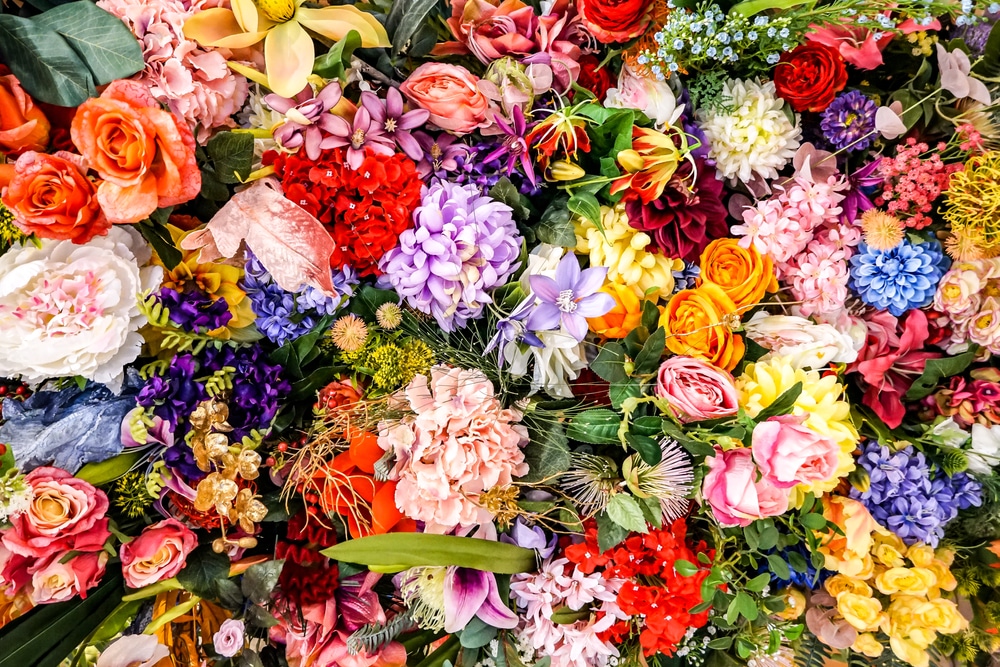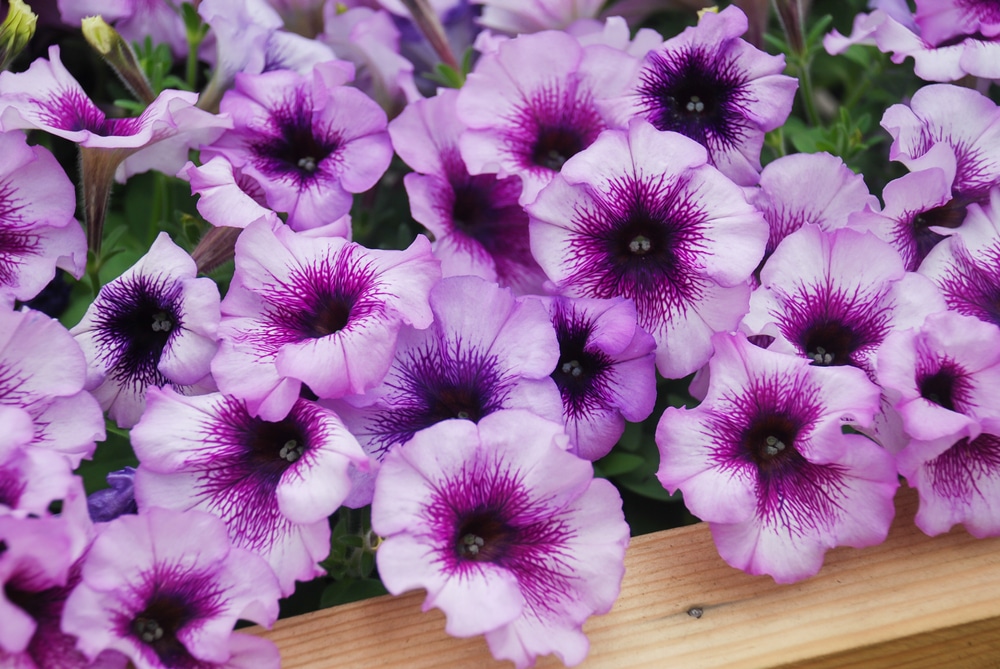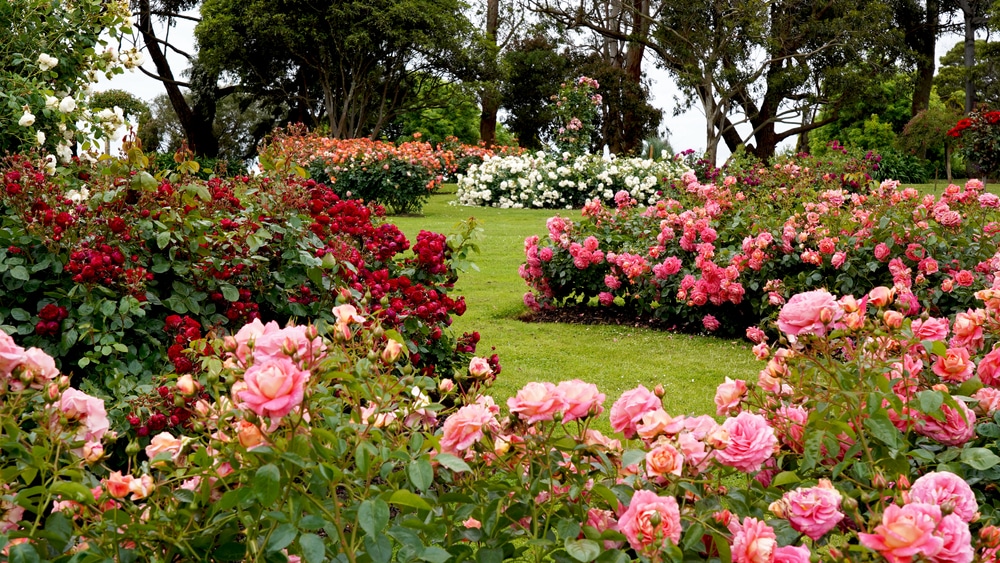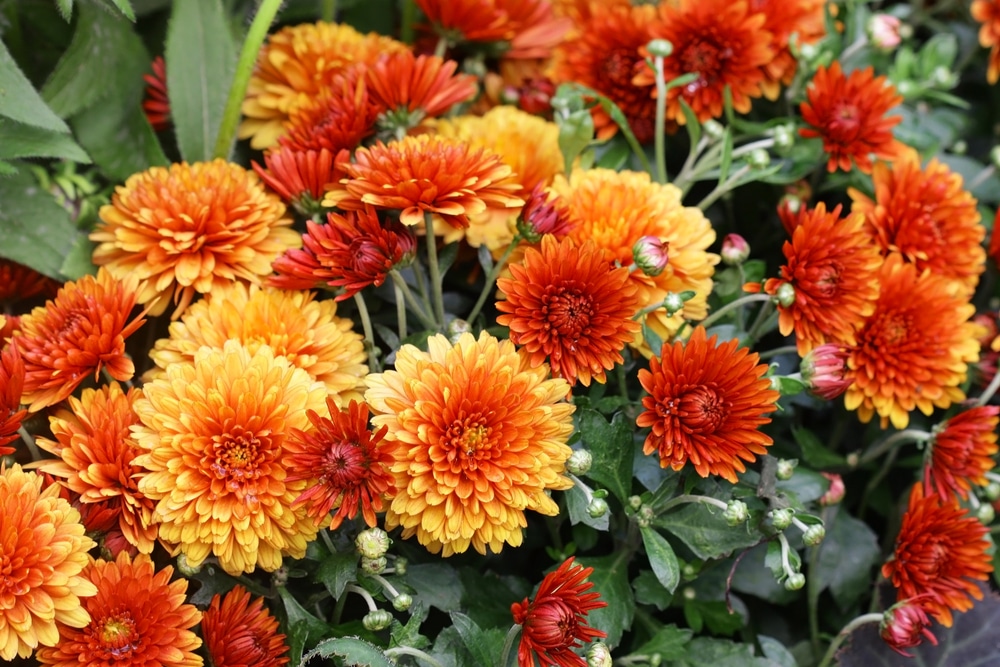Attracting butterflies with flowers is an excellent way to improve your garden’s beauty and productivity. However, you may want to keep bees from joining them. So, what are the best garden flowers to attract butterflies but not bees?
The best garden flowers to attract butterflies but not bees are less fragrant, have hard-to-reach nectar, and are red, pink, or orange. Examples include petunias, geraniums, roses, peonies, poppies, wood lilies, hydrangeas, salvia, eucalyptus, and chrysanthemums.
Why Butterflies Are Both Beautiful And Helpful

Butterflies are one of the most beloved insects on earth (so be careful when handling them!). Many cultures revere them as a herald of happiness and good luck, and they have colorful wings and soft, slender bodies. So, if you intentionally build your garden to draw them in, you’ll end up with a beautiful garden, too.
However, there’s more to butterflies than their beauty. They’re vital to us and the world at large. Many crop plants couldn’t produce our food without pollinators (insects that take pollen from one plant to another).
Why Avoid Bees In Your Garden (But May Not Want To)

Some folks don’t like bees. Maybe it’s because you were stung as a kid, you’re allergic, or you’ve got kids you don’t want getting stung. Whatever the reason, you don’t have to worry because avoiding bees in your garden is as simple as planting flowers they’re not interested in.
However, remember bees are very gentle insects and unlikely to sting you. They’re only interested in eating nectar, making honey, and caring for their hives. Moreover, bees are some of the most important pollinators we have. Like butterflies, bees are essential to plant reproduction, including our crops.
Also, since bees are endangered, providing them the food and environment they need helps to grow their population, which ultimately helps us.
It’s still okay if you don’t want bees around, but they have an important purpose for us and the world. So, the next time you see one, it’s best to let it continue doing what it’s doing.
Tips For Picking Flowers To Attract Butterflies But Not Bees
There are three ways to improve your chances of picking flowers to attract butterflies but not bees to your garden. They involve color, fragrance, and nectar.
Let’s start with color.
Choose Flowers With Certain Colors (Bees Are Colorblind)
Did you know bees are pickier about flowers than butterflies are? There’s a good reason too.
They’re colorblind.
Bees have difficulty seeing the colors red, orange, and pink. Since color is one of the main attractions for pollinators, faded-looking colors like this are much less likely to appeal to bees. Butterflies, on the other hand, can see the whole spectrum. This means you can attract butterflies – but not bees – simply by planting pink, orange, or red flowers.
Also, avoid yellow, purple, and blue flowers, as bees can see these colors.
Choose Less Fragrant Flowers
Flowers also attract bees with their scent. Even if you plant only red, pink, and orange flowers, they may still attract bees if they’re very fragrant. So, while choosing what flowers to plant, ensure they’re the right color and only give off a little fragrance.
Pick Flowers With Hard-To-Reach Nectar
Butterflies are pretty good at reaching hard-to-get nectar, while bees aren’t. This is because butterflies have a more extended proboscis (straw-like appendage) than bees. So, bees prefer wide-open flowers or those with cone-shaped blossoms.
To appeal to butterflies but not bees, plant flowers bees won’t have an easy time getting into. Examples include peonies, roses, and more since they don’t have visible nectar sources (their nectar’s hidden inside their petals).
The 10 Best Flowers To Attract Butterflies But Not Bees

While using flowers to attract butterflies but not bees to your garden may seem challenging, it’s pretty simple. You’ll likely see at least a few bees regardless of what flowers you plant, but you can make seeing them even less likely using the tips above and the flowers below.
Keep in mind the below flowers are not in any particular order (and there are other ways to attract butterflies and pollinators). So, feel free to go with whichever ones work best for you!
Petunias

Petunias are bell-shaped flowers with wide rims. They’re perfect for butterflies to enjoy. Moreover, petunias give off very little fragrance for those looking to avoid bees and are available in colors bees have little interest in (red, pink, and orange), but butterflies do.
Try to avoid petunia colors like purple or white, though, as these may cause bees to become curious.
Geraniums

Geraniums are lovely flowers with a few broad, flat petals and a deep center filled with nectar. They’re pretty fragrant, with a scent like lemon and roses, which bees aren’t fond of.
They’re attractive to butterflies. However, we still recommend planting red, orange, or pink geraniums (to prevent any curious bees passing through).
Roses

Butterflies love roses, as they’re colorful and fragrant flowers. Roses have a heady, dreamy scent that’s immensely popular among people and butterflies alike.
Bees may get curious about white and yellow roses, but they’ll ultimately leave them alone since they can’t reach the nectar easily. We still recommend planting red, orange, or pink roses to avoid bees entirely.
Peonies

Peonies are rose lookalikes with many layered petals. Like roses, peonies have hard-to-reach nectar in a hidden center. This can be frustrating for bees, which will almost always go for an easier meal.
On the other hand, the sugar-sweet fragrance and varied colors are still quite appealing to butterflies. Like other previous flowers on this list, you can make peonies even less attractive to bees by planting red and pink ones.
Poppies

Bees struggle with poppies, making them an ideal inclusion for a bee-free garden. These flowers are quite beautiful, with a few intricately layered petals as thin as parchment paper.
Poppies create nectar-rich bowls that catch the sunlight, lighting up in a stunning display that’s appealing to butterflies. So, consider poppies for your garden, especially the red, orange, and pink ones.
Wood Lilies

Some lilies are quite fragrant, while others have no noticeable scent. They have deep, enormous, bell-shaped flowers that only butterflies, hummingbirds, and hawk moths can easily reach. These flowers are much too intimidating for bees, which could easily get stuck trying to access their nectar.
Wood lilies are one of the best lilies to attract butterflies but not bees, as they’re a muted red.
Hydrangeas

Hydrangeas grow in spherical bunches, each made up of several small flowers. They come in a variety of colors and don’t have much fragrance. They appeal to butterflies, but not bees, especially if you pick pink or red types (but any color should be fine).
Salvia

Salvia grows in spires of tiny, trumpet-shaped blossoms, much like lavender. While purple salvia may attract bees, red salvia will not. On the other hand, butterflies love the blossoms, which are chock-full of nectar.
Eucalyptus

You can always plant eucalyptus if you’d like to keep bees out of your garden. This plant has a fragrant scent that appeals to people yet disgusts bees. Thankfully, butterflies don’t mind the smell and will even roost in eucalyptus trees.
Chrysanthemum

Chrysanthemums look like roses but with narrow petals and much more of them. Their centers are well-hidden and only accessible to butterflies and hummingbirds, not bees. Chrysanthemums also have very little fragrance, so they won’t draw in bees this way, either.
Flowers To Avoid Because They Attract Bees
Along with knowing what flowers to plant to attract butterflies but not bees, you’ll want to be aware of flowers that attract bees so you can avoid them.
So, here are a few of the flowers that bees love the most (and if you’re curious about bees and marigolds, yes, they like those too).
Violets

Violets produce small, pretty, five-petaled blossoms. The most popular color of violet for both bees and people is purple.
Bees love the color purple, and violets’ fragrance draws them in too. The only exceptions are red, orange, or pink violets, which bees won’t find nearly as appealing. You’ll still want to avoid most violets, including white, purple, and yellow, bees’ favorite colors.
Joe-Pye Weed

Joe Pye Weed comes in various hues of purple and has a strong fragrance that draws bees from near and far. So, avoid this one too.
Black-Eyed Susans

Black-eyed Susans look like tiny sunflowers, and their bright, yellow color draws bees like moths to a flame. Like any flower on this list, you can still plant them, but if you want to lower the chances of your garden drawing in bees, then avoid this one.
White Wild Indigo

White wild indigo has tiny, short, white, bell-shaped flowers that are easy for bees to access. The bright color and fragrance are appealing to bees as well.
Blazing Star

Blazing star grows in fuzzy spires. It gets its name from the way it shoots up in a garden.
Unfortunately, bees love these beautiful flowers, especially the white and purple ones. The reddish-pink blazing stars may be okay.
The flowers don’t have much fragrance, but bees are still immensely attracted to the bold appearance and bright color. This is one flower to avoid in a bee-free garden.
Bee Balm

It probably comes as no surprise that bee balm attracts bees. This plant grows in slender stalks with fuzzy flowers on the end. The centers of the flowers are easy to reach, giving bees access to delicious, plentiful nectar.
While pink bee balm may draw fewer bees, they will still stop by. It’s best to go without bee balm for a bee-free garden.
Lavender

Each year, lavender flowers are full of many active, humming bees. Lavender is a bee magnet, so you’ll want to avoid this plant if you’re trying to keep bees out of your yard.
Lilies

While red lilies won’t attract bees, yellow lilies absolutely will. This goes for varieties like yellow lemon and yellow fawn, especially. Remember, if you want lilies in a bee-free garden, choose red or pink ones.
Coneflowers

Last but not least, coneflowers are chock-full of nectar, producing it practically all day. They come in colors bees love, like purple, white, and yellow, and have a honey-like fragrance. Even red and pink coneflowers attract bees, so avoid this flower altogether in a bee-free garden.
Final Advice
As always, the way you cultivate your garden is up to you. You may discover having a few bees around isn’t so bad after all, and you may find the risk of a sting worth the fragrance and beauty certain flowers bring. Besides, since bees and other pollinators are essential to us and the world, why not build a garden they like?

